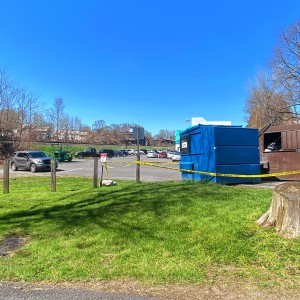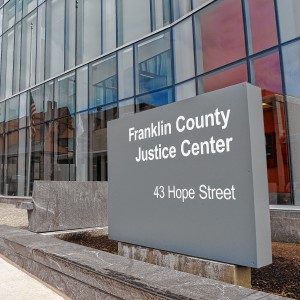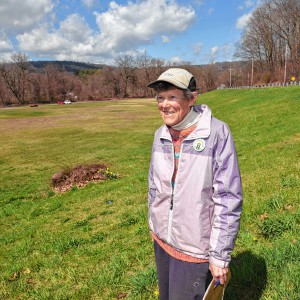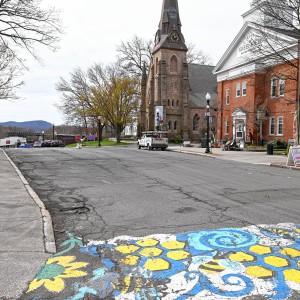Earth Matters: Juvenile plants just not ready to bloom
| Published: 05-08-2023 1:58 PM |
Each spring the Connecticut River Valley is flooded with fresh colors and smells as leaves and flowers burst out of dormant buds on trees and shrubs. Green shoots push up through the last snow and over-top last year’s brown leaves, covering the ground with a new cloak of verdant shapes.
Each new flower and leaf results from a distinct “choice” by the growing point of a plant to bear flowers, or to bear leaves. One or the other! Because once a growing point starts down the path of becoming a flower and ultimately a fruit, there is no going back for that particular shoot.
Fruits and seeds are crucial to the continuation of a plant species, but there also must be leaves to capture the carbon and energy needed for future growth and seed set. As you might imagine, the timing of flowering is a crucial component in the life histories of each type of plant.
Not every plant will bear flowers. Perhaps the day length is not yet right to induce flowering, or there have not been enough cold days. The mechanisms that govern the path to flowering are quite complex, and of course are not really “decisions” in the way we think of picking and choosing. Plants have light sensors that measure the length of day and night, and chemical pathways to keep track of how many days of cold weather have passed since winter brought on dormancy. Many, many factors combine to determine the fate of a growing shoot.
Yet in many cases, when a particular kind of plant would typically flower, say an apple tree, some young trees just do not form flower buds — typical stubborn teenagers! These plants are still in a juvenile state, a situation known by gardeners for centuries. Inducing a tree to flower early could make breeding and fruit production much easier, so many botanists have tried various treatments.
For example, in 1795, Thomas Andrew Knight wrote, “I took cuttings of some old ungrafted pear-trees, and others from scions which sprang out of the trunks near the ground and inserted some of each on the same stocks. The former grew without thorns, as in the cultivated varieties, and produced blossoms the second year; while the latter assumed the appearance of stocks just raised from seeds, were covered with thorns, and have not yet produced any blossoms.”
He went on to conclude from this and other experiments that “every cutting, therefore, taken from the apple (and probably from every other) tree, will be affected by the state of the parent stock. If that be too young to produce fruit, it will grow with vigor, but will not blossom; and if it be too old, it will immediately produce fruit, but will never make a healthy tree.”
There are two things to note here. First, the phase of the shoot, juvenile or mature, stays constant even when growing on a tree in a different phase. The change in the growing tip, whatever it is, is permanent. And more than just the presence of flowers is different — the shoots are thornier and sometimes have leaves of different shape, color or density.
Article continues after...
Yesterday's Most Read Articles
 Greenfield man arrested in New York on murder charge
Greenfield man arrested in New York on murder charge
 Former Leyden police chief Daniel Galvis charged with larceny
Former Leyden police chief Daniel Galvis charged with larceny
 Judge dismisses case against former Buckland police chief
Judge dismisses case against former Buckland police chief
 Greenfield Police Logs: April 9 to April 17, 2024
Greenfield Police Logs: April 9 to April 17, 2024
 Millers Meadow idea would ‘completely transform’ Colrain Street lot in Greenfield
Millers Meadow idea would ‘completely transform’ Colrain Street lot in Greenfield
 Greenfield’s Court Square to remain open year-round for first time since 2021
Greenfield’s Court Square to remain open year-round for first time since 2021
Another plant with very different juvenile and mature forms is English ivy. It has a distinct climbing and spreading juvenile phase with shiny, thick, lobed leaves and a marked tendency to form roots along the stem. The fruiting phase grows as a shrub with clusters of yellow-green flowers that form blue-black berries.
Both forms can be seen growing from the same roots. Once flowering is induced, you can take cuttings from the vine form and get more vines, and get flowers and berries from cuttings of the upright shrubby fruiting form. I have read reports of non-flowering and flowering clones that were propagated by cuttings for30 years without changing phase.
Other plant species have different juvenile and mature leaves. Many, like certain kinds of acacia, grow in New Zealand and Australia. Another local plant, Boston ivy, also has a juvenile form, with leaves that are compound with three leaflets. A mature Boston ivy will flower and fruit and has leaves that are not compound, but entire, with three lobes.
So what is going on here? The permanent change in growth form is not a genetic change, but rather an epigenetic one — that is, a change in the way a gene acts but doesn’t change the gene itself.
We have finally begun to track down what may be changing thanks to work on Arabidopsis, a small fast-growing annual mustard plant. Annuals change in phase from juvenile to mature in one short life cycle. Arabidopsis has juvenile leaves of a very different shape. These plants first grow as a compressed whorl of rounded leaves with short stems for a few days to a few weeks. Then a stem shoots up carrying “adult” leaves that have toothed edges and an elongated irregular outline. The top of this shoot ultimately turns into a flower that produces seeds, ending the life of that plant.
With the advent of molecular biology, and in particular the ability to identify and modify small RNA molecules, it seems that two special kinds of small RNAs accumulate, triggering widespread changes in how plant cells grow and develop.
But then why do these molecules accumulate only at certain rates in certain plant types? Perhaps some plants, like some people, are simply late bloomers.
Lawrence J. Winship (he/him) is emeritus professor of botany at Hampshire College and a former board member of the Hitchcock Center for the Environment.
Earth Matters has been a project of the Hitchcock Center for the Environment for 14 years. After more than three years of the COVID-19 pandemic, the center’s doors and trails are once again open at 845 West St. in Amherst. To learn more, visit hitchcockcenter.org.

 Speaking of Nature: Indulging in eye candy: Finally, after such a long wait, it’s beginning to look like spring is here
Speaking of Nature: Indulging in eye candy: Finally, after such a long wait, it’s beginning to look like spring is here Celebrating ‘Seasonings’: New book by veteran preacher and poet, Allen ‘Mick’ Comstock
Celebrating ‘Seasonings’: New book by veteran preacher and poet, Allen ‘Mick’ Comstock Faith Matters: How to still the muddy waters of overthinking: Clarity, peace and God can be found in the quiet spaces
Faith Matters: How to still the muddy waters of overthinking: Clarity, peace and God can be found in the quiet spaces A time for every purpose under heaven: Free sing-a-long Pete Seeger Fest returns to Ashfield, April 6
A time for every purpose under heaven: Free sing-a-long Pete Seeger Fest returns to Ashfield, April 6
